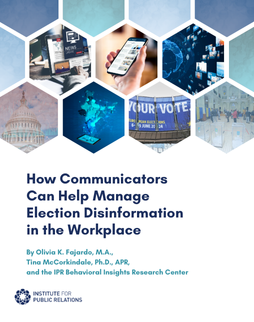This summary is provided by the IPR Organizational Communication Research Center.
Summary
This study examined how the global pandemic brought new challenges to organizational listening and how organizations handle these barriers. Organizational listening is a strategic management function and an ethical responsibility critical to employee-organization relationships (EOR). Ethical listening involves treating others with respect, paying attention to others, giving recognition to others, and responding appropriately. Strategic organizational listening is enabled by senior leadership’s sincere intention to learn and gather insights from employees. Meanwhile, factors such as an open organizational culture, infrastructure to operate listening systems, policies requiring listening, and channels and systems facilitating employee feedback contribute to ethical organizational listening. With COVID-19 in mind, the authors asked four general questions related to organizational listening. First, they explored how communication professionals define and practice ethical or strategic listening. Second, they examined what methods communication professionals use to listen to employees. The third question examined the impact of COVID-19 on internal communication practices, including organizational listening, and the last question asked how internal listening efforts were assessed and whether EOR outcomes were measured.
Method
Thirty interviews were conducted with communication management practitioners in the United States. Participants were selected using purposive and snowball sampling. The sample consisted of 22 women and 8 men. Their average years of working experience in public relations and communication was 22 years. The interviews were conducted on the phone from February to August 2020.
Key Findings
1.) Participants described ethical listening as being present, intentional, and open-minded. Protecting employees’ confidentiality and holding back judgments were also highlighted as part of ethical listening.
2.) Communication professionals used a mixture of interpersonal (e.g., team meetings, town halls, skip-level meetings) and mediated (e.g., emails, video conferencing, mobile applications, intranet, and Facebook workplace groups) channels for listening. Employee engagement surveys and pulse surveys were also utilized to collect employees’ questions.
3.) Regarding the impact of the pandemic on internal communication, the challenge involves observing nonverbal behaviors through videoconferencing platforms.
–Organizations also tended to show greater levels of moral sensitivity (i.e., an awareness of the impact of a decision on the interests of others) when making decisions.
4.) As for assessment tools for listening, results varied among participants. While some reported they did not have measurement tools, others mentioned comparing year-to-year employee engagement survey results and used trust and intent to leave as key indicators in listening assessment.
Implications for Practice
Organizations should 1.) utilize ethical and strategic listening to provide emotional support to employees, 2.) assign communication teams to attend meetings of other departments to gather insights, 3.) find ways to continue to enhance moral sensitivity after the pandemic has receded, and 4.) utilize artificial intelligence to mine employees’ comments for trends, patterns, and issues.
Reference
Neill, M. S., & Bowen, S. A. (2021). Ethical listening to employees during a pandemic: new approaches, barriers, and lessons. Journal of Communication Management. Online Advanced Publication.
Location of Article
This article is available online here.
(abstract free, purchase full article)




